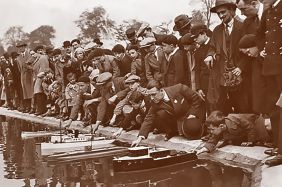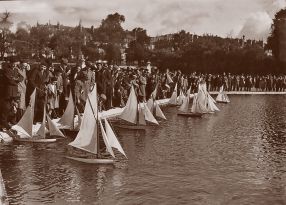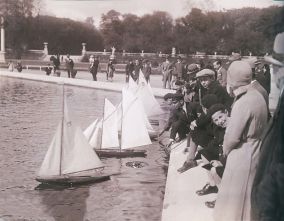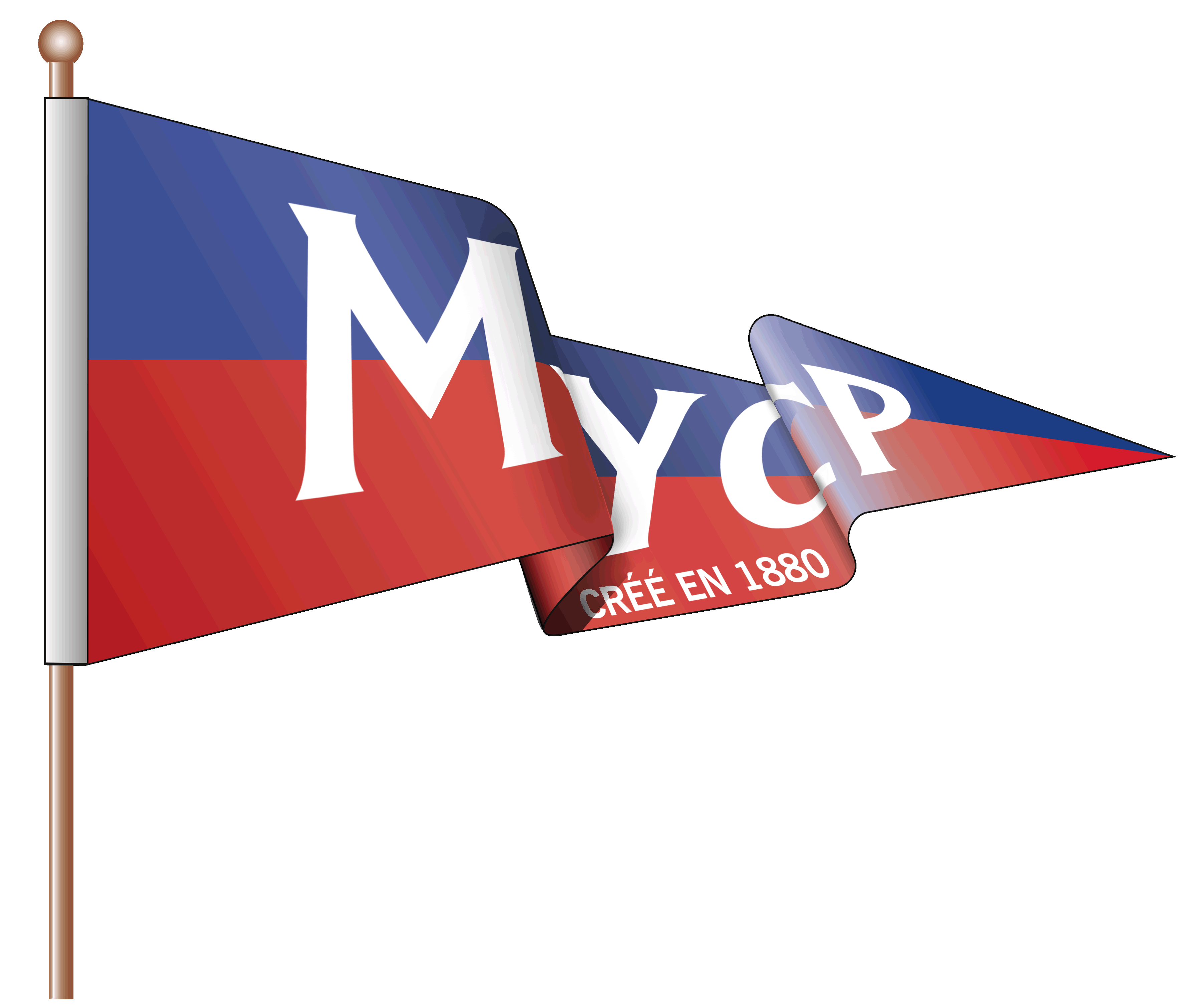Last update : 2021/04/03


MODÈLE YACHT CLUB DE PARIS
NAVAL MODEL MAKING SINCE140 YEARS
Association governed by the law of July 1st,1901, registered on April 6th, 1912 N 155 197
Approval of the Ministry of Youth and Sports N ° 11863 of May 26th, 1952
We are all used to being called "big kids" with our sophisticated "toys",
but I could not imagine until the last few days that other great children who lived
in the late nineteenth century, those worthy gentlemen that we see on the photos of old days
in frock coats and top hats, had preceded us.
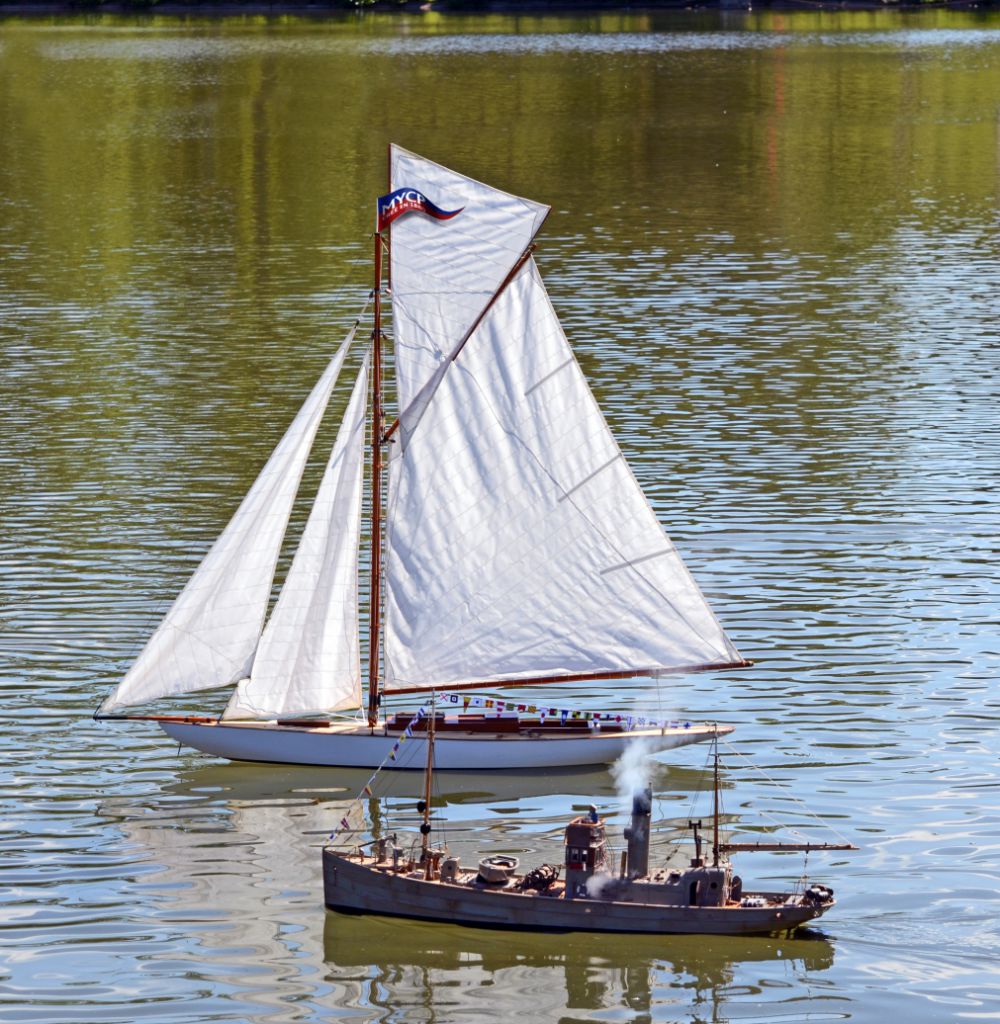
NAVAL MODEL MAKING SINCE THE XIXTH CENTURY
Association governed by the law of July 1st,1901, registered on April 6th, 1912 N 155 197
Approval of the Ministry of Youth and Sports N ° 11863 of May 26th, 1952
Click on the photo to enlarge
1939, departure of a race
" in free sail " on the pond of the Tuileries (Paris).
Departure of a race of electric boats in a straight line on the pond of the Tuileries (Paris).
The first navigations in the thirties on the pond of the Tuileries (Paris).
We are all used to being called "big kids" with our sophisticated "toys", but I could not imagine until the last few days that other great children who lived in the late nineteenth century, those worthy gentlemen that we see on the photos of old days in frock coats and top hats, had preceded us.
A LITTLE HISTORY
Some time ago, I was asked to take the presidency of the MYCP (Modèle Yacht Club of Paris). The name alone already seduces and excites the imagination. It refers to those old times when boating was made of wood, copper and canvas ... I accepted, and once the formalities made, the former president gave me a register in which the history of this club is recorded.
First surprise: everything is written in ink and pen Sergeant Major.
Second surprise, the official registration date of the Model Yacht Club of Paris: 1912. But that's not all: it is indicated in the register that one of the founding members, among those who have died, was "killed to the enemy". If we go back in time, one of the conflicts that precedes this date is the Franco-Prussian conflict of 1870. So, we can assume that the club was created in the middle or the end of the 19th century, when the nations were passionate about the America's Cup, which was a symbol of technological superiority for the winning nation. The townspeople, by creating clubs of reduced-scale models of sailboats which imitated the splendid lines and the elegance of the big boats of this race, could know the same sensations. So this is probably the club's oldest naval model club in France, and perhaps in Europe!
The time spirit is indeed present in this register, as, in the third article, it is specified: "The citizens of the countries which were at war with France in the last European conflict cannot be members of the Society. They are excluded from the races organized by the Society. It is forbidden to any member of the MYCP on pain of exclusion to participate in regattas where they could meet only one citizen of the countries mentioned above ... ". Nationalism flowed naturally at that time!
Another singularity: one of the founding members was an aristocrat, the Marquis de la Jaille. No wonder, when you know that in those days, yachting was a matter of money, and also of social class. We just have to look at the elegance of the officials who handed the trophies to the winners on the photos. It was the time when the President of the Republic himself, Raymond Poincaré, who had a certain attraction for the things of navigation, handed over to the modellers of the time the International Regatta Cup of the Three Nations of Enghien les Bains. The model clubs belonged to this world.
What a legacy!
AN EXTRACT OF THE STATUTES
Article 1: The goal of the Society is "to encourage and develop the taste for the construction and the navigation of model yachts". One can imagine that this club practiced only sailing, because the steam engines of the time had a small efficiency, so imagine reduced-scale models! This assumption is confirmed by all the articles of the regulation which define the organization of regattas. Radio control was far from existing, so at that time they had to practice free sailing.
The financial contributions of the active members were set at 10 francs, and at 3 francs for underage members.
Regatta commissions were created to enforce the regulations developed by the board of directors. The members of these commissions were elected for one year by the general assembly.
Three series were admitted in regatta: the 0.80 m and 1 meter international gauge series, the fishing models serie, and the 6.50 m reduced to 1/10th national serie.
This club was under patronage of the Yacht Club de France because from 1912 (and perhaps before, having no archive) till 1928, the same person, Mr. Marcel Bar, was the president of both clubs.
People living outside the Paris region or professional naval architects could be appointed by the board of directors as "corresponding members".
The board members included industrialists, naval architects, executives, and perhaps the first female model maker, Suzanne Terre, registered in 1951.
With time, the Modèle Yacht Club de Paris opened to all naval modeling disciplines.
THE PONDS OF THE MYCP IN THE PAST
The pond that imposed itself from the beginning was the one of the Tuileries for its strategic situation: the attendance of the public was certain. The sailboats with their auric rigging did not mismatch in the majestic setting of the Palais du Louvre.
In the early fifties, the club obtained an official agreement to sail on the Tuileries pond, on Lake Saint James in the Bois de Boulogne, and on the Canal in the Parc de Sceaux in the Hauts de Seine, as the Tuileries pond became too small for the organization of steamboats, electric or sails competitions. It was only used for fame contests. Imagine, at that time, although the authorized speed limit was 30 km/h, the evolutions of thermal boats were authorized without restrictions ...
However, regularly, the MYCP organized meetings on other ponds, on its own initiative or at the request of a municipality such as Conflans Ste Honorine, where the members of the club created a storage yard for boats .
Until the arrival of radio control, the goal was to rally as quickly as possible the bank opposite to departure. Other events were also organized: what was rewarded was the stability of the route followed by the sailboats, or the correctness of the course. This was done by setting targets that the boats had to touch with their bowsprit. It was a prosperous time, the meetings could be organized by magazines, including MRB (the French model boats magazine), by model shops and even by the Ministry of the Navy.
It was not uncommon to see young women participate in regattas. One of them, in 1946, Miss Arlette Camus, won the cup of Paris Press Junior in the category of 75 cm, a cup which took place on the Tuileries pond. She will become Mrs. Paudeau, the wife of the famous sailboat designer of the Luxembourg pond.
SOME NOTICEABLE ELEMENTS
In 1945, the MYCP organized the "Duck Cup" with special sharpies. The first prize was a live duck. A very appreciated prize in these times of rationing.
Among the trophies given to the competitors, there were combustion engines, sailboats kits, and many books such as Gems Suzor's ones; that man was president of the MYCP from 1944 to 1968; this was the proof of a great stability, because at that time the executive office was renewed every year.
Gems Suzor was a great propagator of the "model-making" spirit. He published books on motorization, and also wrote many articles about steam engines in MRB. As a tireless builder, he also gave us many engine plans.
Another member of the board, Adrien Sentz, also wrote a number of articles for MRB.
MRB and MYCP is a long history of collaboration!
MYCP is also one of the founding clubs of the FFMN (French Federation ol naval model making).
For a long time, for most French and foreign clubs, the MYCP initials were the ones of the Modèle Yacht Club de Paris, the oldest club which was registered after the club of Bordeaux. For more than a century, its activities have always been directed towards the development of naval model making in France and abroad. All the current clubs are a little indebted to the MYCP: its dynamism and its determination to go forward must continue to serve us as a model.
Your servant, president, Jean-Pierre Cusset, secretary, and Raphaël Havranek, treasurer, will take charge of the destiny of MYCP and try to be worthy of such a legacy.
Serge DUCRUIT
